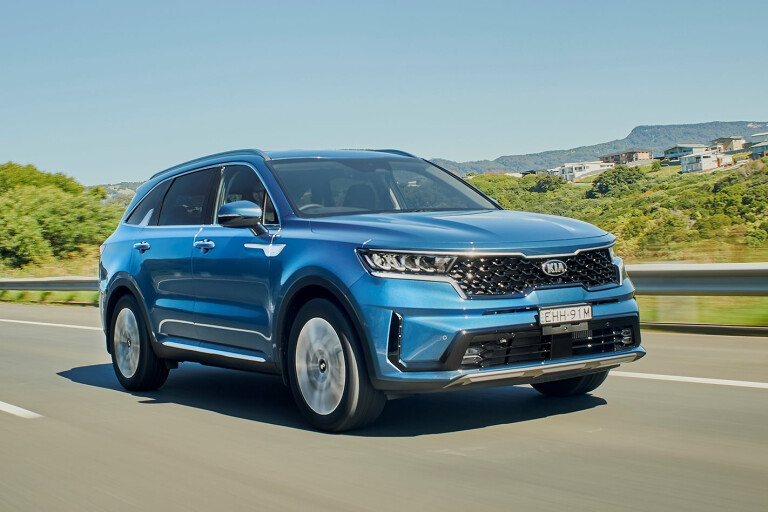
Score breakdown
Things we like
- Features
- Smooth and potent diesel
- Warranty
- Auto braking
Not so much
- Thirst of petrol V6
What stands out?
The fourth-generation Kia Sorento seven-seat SUV is the most advanced Kia model to date and, like its predecessor, is beautifully finished inside, generously equipped, and enjoyable to drive. The optional diesel engine is refined and powerful, and a suite of active safety features and Kia’s seven-year warranty bring peace of mind.
.jpg )
You can also read our review of the Sorento this all-new model replaced in September 2020.
What might bug me?
Not much, perhaps not having an all-wheel-drive option if you want a petrol Sorento.
Being concerned that third-row passengers, who are most likely to be children, are not protected by airbags. The curtain airbags in a Sorento only protect the first two rows.
Otherwise, what you see is pretty much what you get with the Sorento – it’s not likely you’ll be ambushed by annoying surprises. It even has a full-sized spare wheel and tyre, and the rim is aluminium alloy like the others on the car.
What body styles are there?
Five-door SUV-style wagon only.
The Kia Sorento drives either its front wheels or all four wheels. It is classed as a large SUV, lower priced.
.jpg )
What features do all Sorentos have?
- A colour touchscreen, for controlling the infotainment system and other cabin functions.
- Support for Apple CarPlay and Android Auto, which lets you display apps from compatible smartphones on the central screen and control them from there.
- An MP3-compatible sound system with AM/FM and digital radio (DAB+), Aux and USB inputs, Bluetooth connectivity for phone calls and audio streaming, and audio controls on the steering wheel.
.jpg )
- Reversing camera with guidelines.
- Front and rear parking sensors.
- Digital gauges.
- Active safety including autonomous emergency braking with pedestrian, cyclist and junction detection, lane-keeping assist, rear-cross traffic alert, blind-spot collision avoidance, driver attention alert.
- 'Smart' adaptive cruise control with stop and go function that works in slow traffic.
- Full LED lighting including headlights, daytime running lights, front and rear fog-lights.
- Rain-sensing windscreen wipers.
- Wheels made from aluminium alloy, which are usually lighter and better looking than steel wheels with plastic covers. A full-size spare tyre, on an alloy wheel.
- Auto-folding door mirrors.
- Roof rails.
- Sliding and reclining second-row seats.
- Every Kia Sorento carries a seven-year, unlimited-kilometre warranty.
Which engine uses least fuel, and why wouldn't I choose it?
All front-drive Sorentos use a petrol engine, and every all-wheel drive Sorento is powered by a turbo diesel.
The Kia Sorento range will also gain hybrid and plug-in hybrids powertrains built around a 1.6-litre petrol turbo engine in early 2021. The plug-in hybrid will be the most economical, but until then it is the 2.2-litre four-cylinder turbo diesel that uses the least fuel, consuming 6.1 litres/100km on the official test (city and country combined).
In many respects, an AWD diesel Sorento is preferable to its front-wheel-drive petrol alternative. The diesel accelerates the car with powerful ease from low speeds, offering about 40 per cent more urge than the petrol engine in most driving conditions. And AWD is nice to have for its extra traction on slippery surfaces.
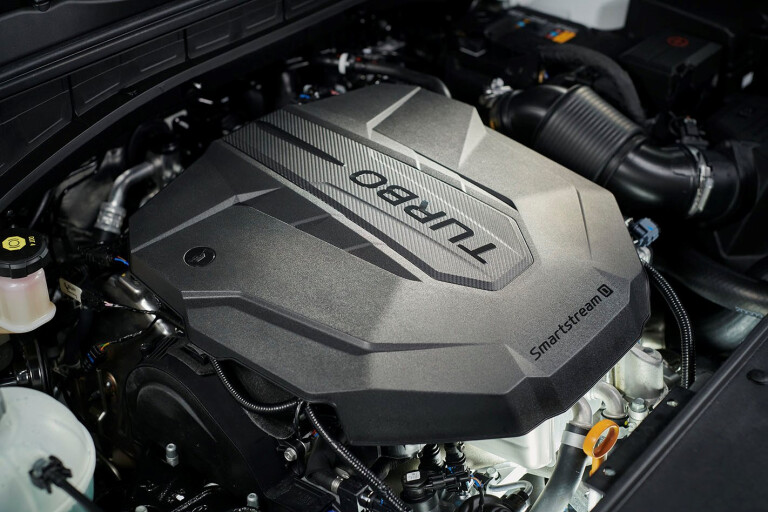
The main reason you might not choose a diesel is that you want to pay less for a Sorento.
The petrol engine, a 3.5-litre V6, drinks substantially more fuel than the diesel, at 9.7 litres/100km on the same official test. However, it does produce more power if you work it really hard.
The petrol Sorentos have an eight-speed conventional automatic gearbox, and the diesels an eight-speed dual-clutch auto.
You can have either engine with any Sorento spec grade.
Power outputs and all other Kia Sorento specifications are available from the Cars Covered menu, under the main image on this page.
What key features do I get if I spend more?
The least costly variant is the Sorento S, which has cloth upholstery, an 8.0-inch touchscreen, 17-inch wheels, and the features common to all versions.
Stepping up to the Sorento Sport sees the touchscreen size increase to 10.25 inches and the alloy wheels to 19 inches.
.jpg )
Other extras include:
- Satellite navigation with 10 years of traffic information and map updates.
- Dual-zone climate control air-conditioning.
- Auto-dimming rear-view mirror.
- 10-way powered drivers' seat settings.
Paying more again for the Sorento Sport+ brings:
- Leather-appointed seats.
- Heated front seats.
- Heated steering wheel.
.jpg )
- Smart keyless entry and push-button and remote-engine start.
- Heated door mirrors.
- Hands-free powered tailgate.
- Privacy glass.
- 2nd and 3rd row USB sockets
The range-topping Sorento GT-Line comes with a host of extras over the Sport+ including:
- Smart key with remote smart parking assist.
- 12.3-inch high-resolution digital instrument cluster.
- Head-up display.
- In-car intercom.
- 360-degree parking camera.
- Parking collision avoidance (auto-braking) which works in reverse.

- Dual-projection LED headlights.
- Blind-spot monitor.
- Quilted Nappa leather seats.
- Heated front and outboard rear seats.
- Ventilated front seats.
- 14-way power-adjusted driver's seat.
- 10-way power-adjusted front passenger seat.
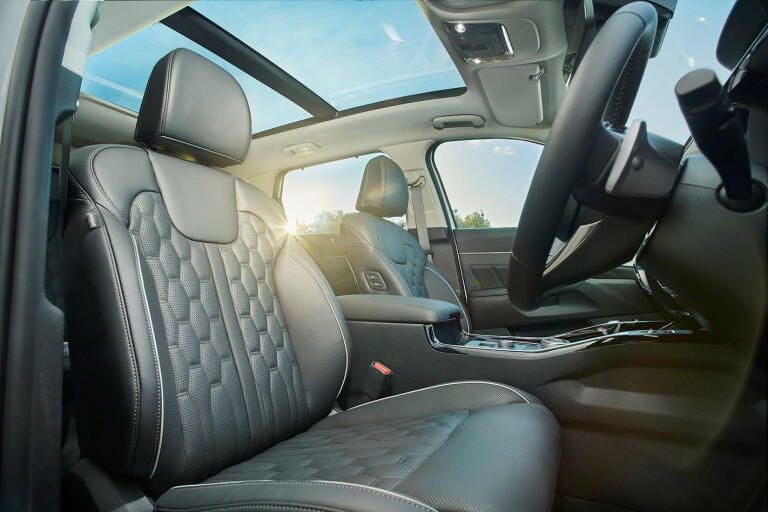
- Panoramic sunroof.
- Paddle shifters.
- Interior mood lighting.
- Alloy sports pedals.
- Wireless fast phone charging.
- BOSE premium sound system.
- 20-inch alloy wheels.
Does any upgrade have a down side?
The Sorento S, on its 17-inch wheels, rides more comfortably than the Sport, Sport+ and GT-Line, on their 19s and 20s. The lower-profile tyres on the bigger wheels have less rubber and air cushioning the wheels from the road. The difference is most pronounced at city speeds.
The GT-Line’s bigger wheels and panoramic sunroof can lead to more road and wind noise, too.
How comfortable is the Sorento?
So far we’ve only driven the most expensive Kia Sorento, the turbo-diesel GT-Line, but it’s obvious this model is a further improvement over the very good previous generation. It imparts a feel-good factor thanks to the use of quality materials and cool design; higher pricing feels reasonable given what it delivers.
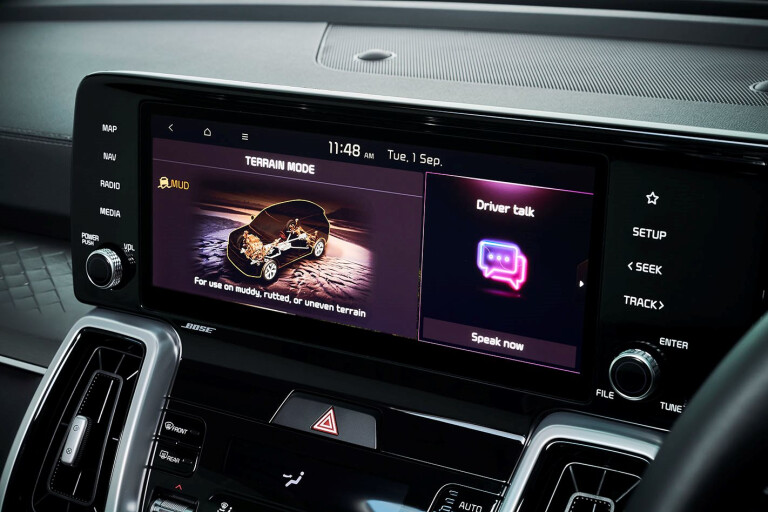
The Sorento feels spacious, upmarket, and intelligently designed, with evidence of comfort and convenience equipment everywhere you look. It’s hard not to stop and admire the crisp resolution and cool graphics of the big 10.25-in touch screen and the way (in the GT-Line) it seamlessly merges with the 12.3-inch digital instruments.
Space and comfort for those in the second and third rows is excellent. Second-row seats are able to slide 45mm further, creating the option for more legroom, and providing a wider point of entry to the third row. In terms of ventilation, storage and access for passengers, it’s all hard to fault.
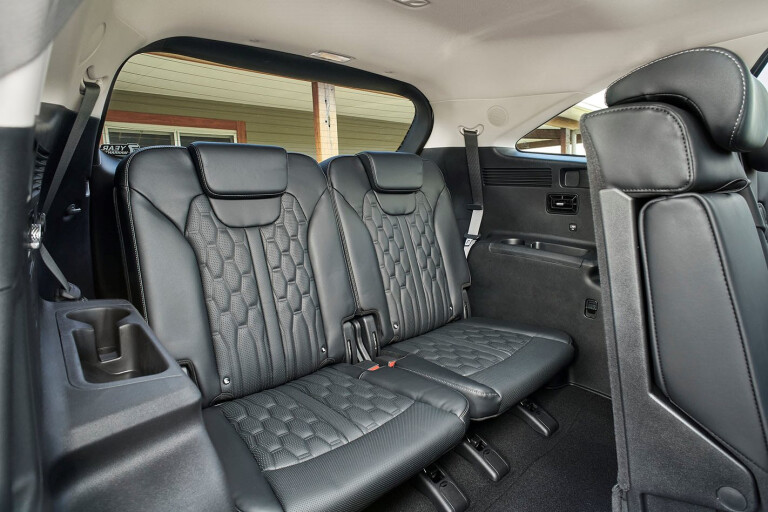
On the road there’s palpable composure and confidence in the way it tackles bumps and turns into bends, again marking a new high for an Australian chassis tune from Kia.
One thing we really like about the GT-Line is how, if you’ve parked it in a tight space hindering door opening, you can extract it with the driverless ‘remote park assist’ function while standing outside using the key fob.
What about safety in a Kia Sorento?
Anti-lock brakes, stability control, a strong body structure, eight airbags, LED running lights, a reversing camera, and seatbelt warnings for all positions, are fine safety fundamentals in all Sorentos.
There are two airbags directly in front of the driver and front passenger; one alongside each front occupant to protect the upper body and two more that pop up between the front seats to prevent occupants colliding with each other during impact.
A curtain airbag down each side protects the heads of those riding in the front two rows, but does not cover the occupants in the third row of seats.
All Sorentos have autonomous emergency braking (AEB) that brakes the car automatically to prevent or mitigate an impact with an obstacle in front (typically another car that has slowed suddenly). The Sorento’s system works at highway speeds, and at slower city speeds where it can detect and brake for pedestrians and cyclists.
The Sorento's AEB also has Junction Detection that can sense a vehicle entering an intersection in front of you and apply the brakes if necessary.
Each Sorento version is equipped with lane-keeping assist, which helps keep the vehicle between the white lines should you become distracted, and a driver attention alert, which produces a visual and audible alarm if it senses wayward driving that could be caused by fatigue, and front- and rear- cross-traffic alert warns you if something is crossing your path when travelling forward or in reverse.
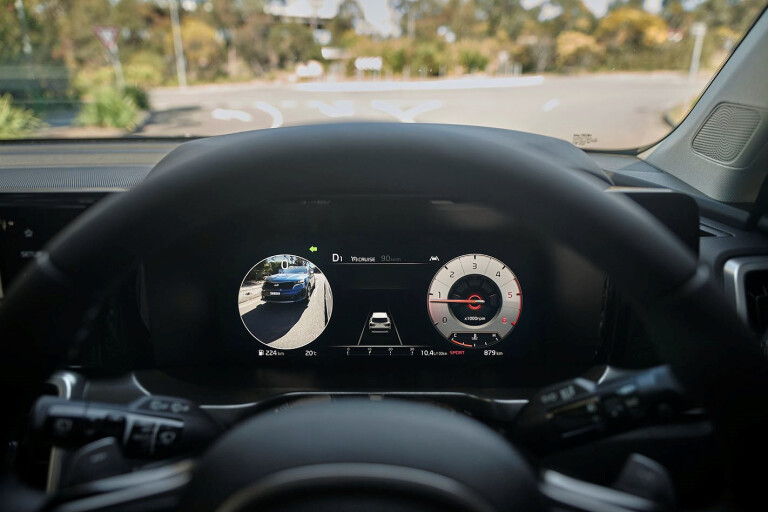
There is also intelligent speed limit assist, and smart adaptive cruise control with Stop & Go function and traffic sign recognition.
The Sorento GT Line also has a Blind spot monitor, which warns you when a vehicle is alongside out of view and displays a camera image in the instrument panel when the indicator is activated.
The Australasian New Car Assessment Program (ANCAP) awarded the diesel Sorento its five-star rating in December 2020 based on its excellent Euro-NCAP results.
It performed well across a variety of physical crashes and bolstered that performance with a ‘very strong’ Safety Assistance score of 89 per cent – the highest score achieved to date under ANCAP's 2020’s new stringent assessment criteria.
However, the ANCAP rating only applies to the diesel versions of the car, and not the petrol-powered variants.
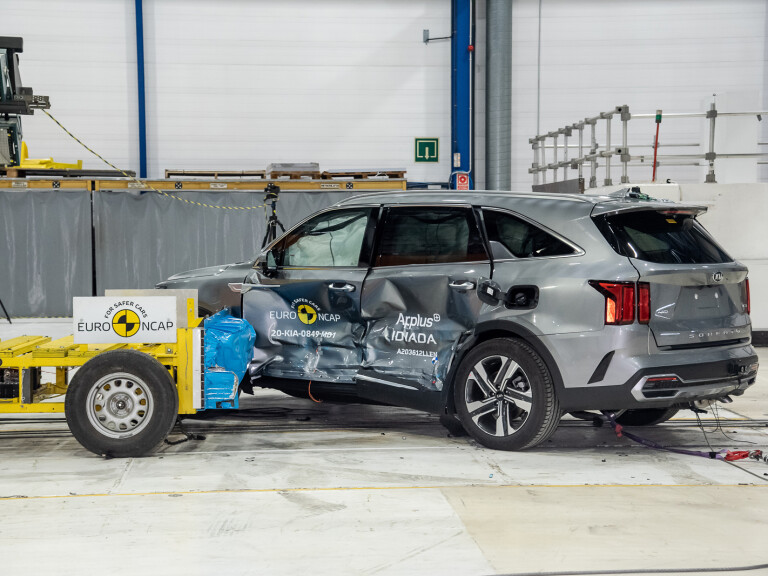
It's worth noting that five-star safety rating is only applicable to diesel versions of the Kia Sorento as no petrol versions are sold in Europe (therefore no petrol cars on-test). This means the petrol versions remain unrated, but we doubt very much, based on how well it scored across impact and crash-prevention categories, that the engine would make a difference.
Click here to see the full ANCAP overview.
I like driving - will I enjoy this car?
So far we've only driven the GT-Line AWD diesel, but there are obvious improvements to ride, handling and noise levels compared to the previous model, which was one of the better-driving large SUVs
On the move, the diesel powertrain feels eager and lively and the eight-speed dual-clutch automatic doesn’t have the jumpy lag at slower speeds you expect from such transmissions. It also has drive modes including Comfort that sees it respond instantly to a light foot, and Sport that grabs gears up or down with near-perfect intuition.
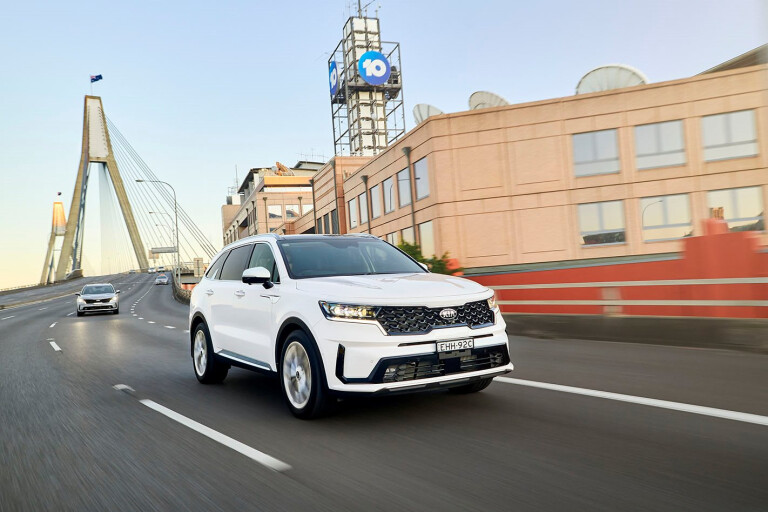
The electric power steering was always excellent in the Sorento, and the new version provides even more direct response. Selecting Sport mode adds additional weight to the tiller for more precise cornering.
Like all Kia’s, the suspension has been recalibrated in Australia to suit rougher local roads resulting in a better ride, and less body roll in corners.
Turbo-diesel Sorentos surge forward when you press the accelerator. You will love the effortless oomph the engine provides – it’s a big part of what makes it so satisfying.
The petrol car isn’t quite so potent at low engine speeds but offers similar shove at medium engine speeds.
How is life in the rear seats?
Second-row passengers have it good in the Sorento. The seat is supportive, and the rear compartment is roomy. Each version has a centre armrest (with twin cupholders) and a 12-volt socket, and air-conditioning vents.
The Sport+ and GT-Line have two rear USB sockets for charging electronic devices, while the GT-Line also has handy roll-up sunshade blinds and heated outboard seats.
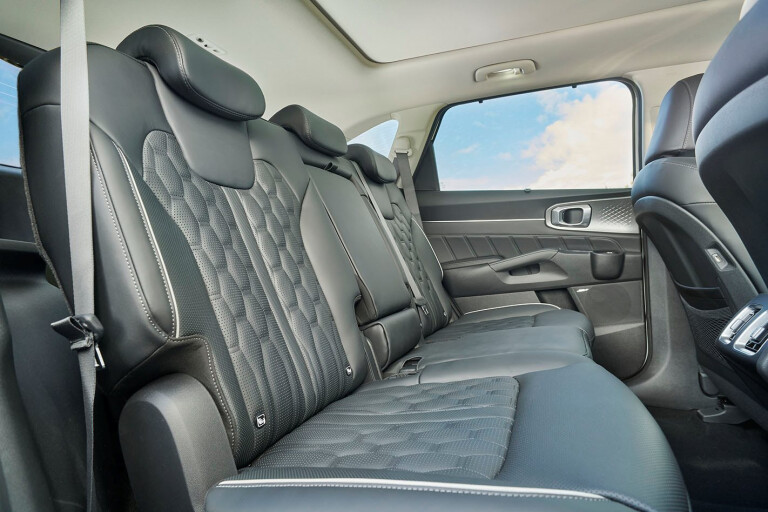
The third row is a little cramped to be comfortable for adults on long trips, but it’s roomy enough for children. The second row seats can slide forward up to 45mm for a little more third-row legroom.
Third-row conveniences include air-conditioning vents and fan controls (except Sorento S), and a good view forward and out of the side windows. The Sport+ and GT-Line also has two USB sockets back there.
The third-row does however miss out on curtain airbag protection.

The Sorento is also quite the baby bus - the second and third rows each have two ISOFIX child seat anchor points and there are top tethers for all five rear seating positions.
How is it for carrying stuff?
The Sorento's space is up from 605 litres in the previous model to 821 litres with the third row of seats folded down. With the third row in use, available cargo space is up 32 percent to 187 litres.
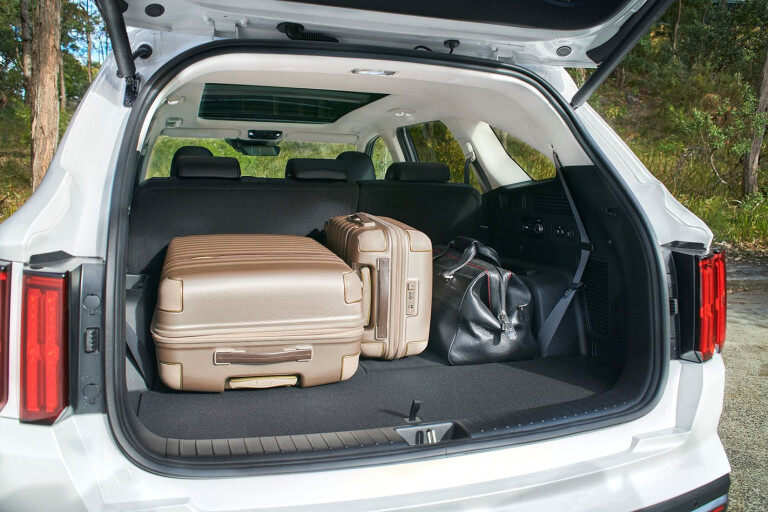
The hands-free powered tailgate in the Sport+ and GT-Line versions opens when you walk up to it with the car’s key in your pocket. That eases loading when you have your hands full.
Both petrol and diesel Sorentos have a braked towing capacity of 2000kg and 750kg unbraked. The maximum towball down-weight is 200kg.
Where does Kia make the Sorento?
The Kia Sorento is made in South Korea.
What might I miss that similar cars have?
Not much. The Sorento is very-well equipped.
Perhaps for now a hybrid version as available with the Nissan Pathfinder, though hybrid and plug-in hybrid versions are due to join the range in early 2021.
MORE: The cheapest seven-seat SUVs on sale right now
Comparable large seven-seat SUVs you might consider include the Mazda CX-9 or CX-8 if you prefer diesel, Toyota Kluger, Skoda Karoq and Hyundai Santa Fe.
If comfortable travel for seven is more important than getting off the beaten track, perhaps consider the Kia Carnival, which has more room in the third row and easier access to it.

Are there plans to update the Sorento soon?
The fourth-generation Kia Sorento replaced the third-generation model in September 2020 for the 2021 model year, with the initial line-up featuring S, Sport, Sport+ and GT-Line spec grades each with FWD petrol and AWD diesel versions.
Hybrid and plug-in hybrid versions are expected to arrive in the first quarter of 2021.
An update is not expected until late 2023.
I like this car, but I can't choose which version. Can you help?
We like the Sorento Sport+, because it strikes a pleasing balance of price and equipment. Ultimately, the diesel is a better bet than the petrol, because it has more grunt and uses less fuel. If the extra fuel use and absence of AWD are not drawbacks for you, the petrol is worth a look, too.
.jpg )
Score breakdown
Things we like
- Features
- Smooth and potent diesel
- Warranty
- Auto braking
Not so much
- Thirst of petrol V6
COMMENTS